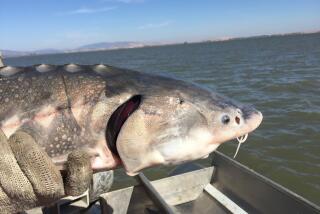Scientists and fishermen fight to save leatherback turtles, California’s official marine reptile
- Share via
Reporting from San Diego — Despite strict protections off the West Coast, leatherback turtles are in danger in other parts of the Pacific, scientists and fishermen said at a conference called to celebrate California’s official marine reptile.
The meeting, held recently in La Jolla, offered a status update on the ancient marine species in advance of California’s Pacific Leatherback Conservation Day on Saturday. With populations down by more than 90% since the 1980s, the animals are ranked as one of eight marine species at greatest risk of extinction, according to the National Oceanic and Atmospheric Administration’s National Marine Fisheries Service.
Fishermen and researchers say that U.S. fishing limits designed to keep leatherbacks from getting caught in nets may unintentionally lead to more ensnarement in countries where rules are looser. For the globally roaming species, it will take more than one country’s efforts to stave off extinction.
Leatherbacks are oceangoing leviathans that can weigh up to a ton and swim nearly 7,000 miles across the Pacific, devouring jellyfish.
“Movements by the leatherback are the longest migration of any air-breathing aquatic vertebrate,” Scott Benson, a marine ecologist with NOAA Fisheries, said at the conference.
Born in nesting beaches of Indonesia, the animals travel to the California Current. It’s the richest foraging ground for jellies, Benson said, and also the safest haven for the turtles because of stretches off Northern California, Oregon and Washington where fishing is restricted.
Federal rules limit fishing methods and gear, require observers on fishing boats to report any leatherbacks snared in fishing nets, and set seasonal closures on drift gill net fishing — which is used to catch swordfish but can also trap turtles, whales, dolphins and other animals.
As the U.S. has tightened protections for the turtles, however, access to locally caught swordfish has dropped. In its place on menus and at fish markets is imported frozen swordfish, caught in parts of the world without such fishing restrictions.
That’s leading to a call among fishermen and conservationists alike to revive the U.S. swordfish industry.
“We want to see a healthy domestic fishery,” said Geoff Shester, California program manager for the conservation group Oceana. “Part of saving the leatherback is bringing back clean, sustainable fishing that we can control.”
Some fishermen call for relaxing U.S. fishing restrictions, arguing that they could produce locally caught swordfish with less risk to turtles than imported fish. Real time monitoring of turtle movements could help fishermen steer clear of the reptiles while maximizing the swordfish catch, they say.
Others are testing new gear that could help catch swordfish at times and depths that pose little risk to leatherbacks. And regulators are demanding that fish importers prove they’re safeguarding turtles.
“Countries that export fish into our country will have five years to meet our standards for protecting leatherbacks,” said Tina Fahy, a fishery biologist for NOAA. “It’s a huge game changer.”
In the meantime, they’re encouraging consumers to pay more attention to what’s on their plates.
“There’s a growing percentage of the population that cares where their food comes from,” said Dave Rudie, owner of the San Diego fish distributing company Catalina Offshore Products.
“Buy fish caught by American fishermen,” he said. “Ask your fishmonger; ask the server at the restaurant. The collaboration between scientists and fishermen is very, very powerful, and we should always be encouraging it.”
deborah.brennan@sduniontribune.com
Brennan writes for the San Diego Union-Tribune
More to Read
Sign up for Essential California
The most important California stories and recommendations in your inbox every morning.
You may occasionally receive promotional content from the Los Angeles Times.













